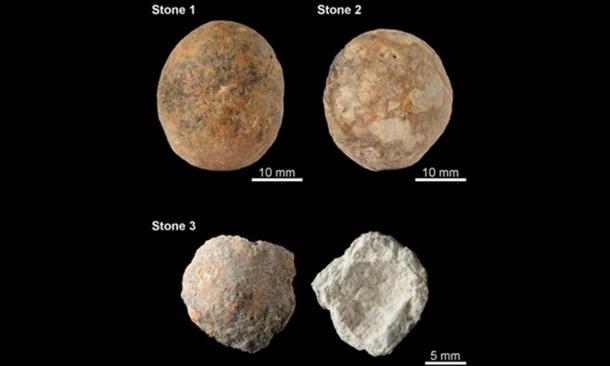
Prostate Stones the Size of Walnuts Made Life a Nightmare for a Man 12,000 Years Ago
The earliest known case of prostate stones, roughly the size of walnuts and dating back about 12,000 years, has been discovered in the skeletal remains of a man in a cemetery in central Sudan. The stones, which cause excruciating pain, were in the man’s lower urinary tract or prostate area.
The man lived with the knowledge that there was little prospect of relief from his condition, which may or may not have killed him, a new paper says about the case. The authors quote French philosopher Michel de Montaigne, who said , “What is this [torture by the stone] but testing of death again and again? Deliver me, if possible, from his evil which is in me”

The photos show the prostate stones in context in the grave. Prostate stones often develop without symptoms of pain or complications. But this man’s stones were so large that he likely suffered terribly and possibly suffered other conditions in addition to pain and difficulty urinating. Source: Usai et al.
This finding, plus an earlier one in Sicily in a woman dating to about 8,500 years ago, reveal that the condition of lithiasis or stones building up in the body afflicted humans long before the modern era.
- Ancient skull was drilled and harvested for medicine in the 18th century
- Researchers find oldest known case of cancer in 4,500-year-old remains of Siberian man
- What the ancient Mayans can teach us about health and healing

The team of scientists was able to nail down what part of the body the man was inflicted by the stones by their position underneath the body and by the crystalline mineral makeup of the stones. (Usai et al.)
The man in this case likely suffered enormously from the stones, but they were not his only problem. The team, who published their findings in the journal PLOS One, was led by Donatella Usai and Sandro Salvatori of the Center for Sudanese and sub-Saharan studies in Treviso, Italy. They wrote:
‘… the occurrence of bacterial imprints also indicates on-going infectious processes in the individual. This discovery of the earliest known case of lithiasis [stone formation] extends the appearance of prostatic stones into the Late Pleistocene/Early Holocene, a disease which therefore can no longer be considered exclusive to the modern era, but which also affected prehistoric individuals, whose lifestyle and diet were significantly different to our own.’
Lithiasis is known to have occurred prior to mentions of it in ancient records from Babylon and Egypt. But the earlier finding in Sicily and this one in Sudan, about 20 kilometers (12.43 miles) south of Khartoum on the left bank of the White Nile, push the disease much further back in prehistory.

These prostate stones are about the size of walnuts and likely afflicted a man with excruciating pain 12,000 years ago. (Center for Sudanese and sub-Saharan studies in Treviso, Italy)
The team examined graves of 194 people from three eras: pre-Mesolithic or Middle Stone Age, Neolithic or New Stone Age, and the Classic/Late Meroitic of about 700 BC to 350 AD.
Most of the burials, 94, were in the pre-Mesolithic of around 12,000 years ago. Those burials were peculiar for having such a large number of bodies buried facedown. Only one other case of a facedown burial has ever been seen in the Nile Valley. The authors do not think they were buried in what are known as deviant burials, in which people are buried face down or with stones piled on top of them to prevent them from rising from the dead to haunt the living.
- First Ever Evidence for Ancient Bone Surgery found in Peru - Holes Drilled in Legs
- Traditional African Medicine and its Role in Healing in a Modern World
- When Millions Were Dropping Dead From the Plague, The 14 Holy Helpers Were Summoned to Intercede
The skeletal remains of these people showed they were generally tall, well-fed, and healthy - except for tooth decay, the paper states. People in Sudan in those days had a better climate than that country enjoys now. They likely had a rich, stable ecosystem from which they hunted and gathered food.
“Hence, while it is impossible to establish conclusively whether the Al Khiday individual died as a consequence of the lithiasis, in light of the touching descriptions described in literature regarding people suffering from this pathology, it is highly likely that this individual experienced extreme pain during the course of this disease, without the possibility of relief.”

Detail of one of the stones in the man’s pelvis at the grave. (Università di Padova)
If you’re reading this article on a computer, you may take medical treatment for granted. However, much of the world is still trapped in poverty and has no recourse to doctors or other health practitioners or medications. So while this disease of lithiasis is very old indeed, many people still live with it with no hope of a cure or to ease their suffering.
Featured image: The photos show the prostate stones in context in the grave. Prostate stones often develop without symptoms of pain or complications. But this man’s stones were so large that he likely suffered terribly and possibly suffered other conditions in addition to pain and difficulty urinating. Source: Usai et al.
By Mark Miller















